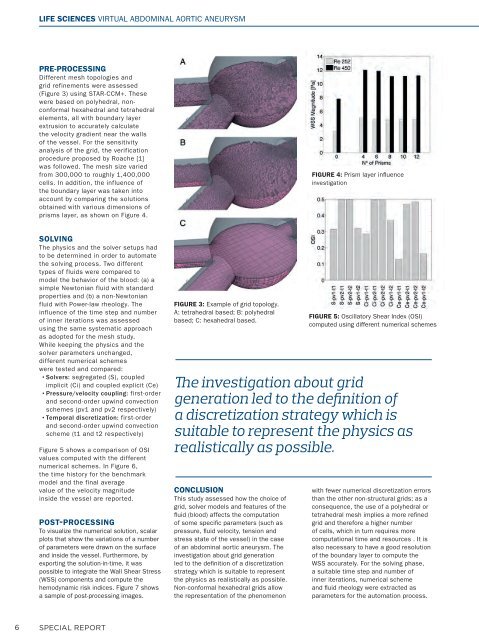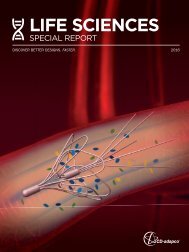Life science special report 161215 IY opt
Create successful ePaper yourself
Turn your PDF publications into a flip-book with our unique Google optimized e-Paper software.
LIFE SCIENCES VIRTUAL ABDOMINAL AORTIC ANEURYSM<br />
PRE-PROCESSING<br />
Different mesh topologies and<br />
grid refinements were assessed<br />
(Figure 3) using STAR-CCM+. These<br />
were based on polyhedral, nonconformal<br />
hexahedral and tetrahedral<br />
elements, all with boundary layer<br />
extrusion to accurately calculate<br />
the velocity gradient near the walls<br />
of the vessel. For the sensitivity<br />
analysis of the grid, the verification<br />
procedure proposed by Roache [1]<br />
was followed. The mesh size varied<br />
from 300,000 to roughly 1,400,000<br />
cells. In addition, the influence of<br />
the boundary layer was taken into<br />
account by comparing the solutions<br />
obtained with various dimensions of<br />
prisms layer, as shown on Figure 4.<br />
FIGURE 4: Prism layer infl uence<br />
investigation<br />
SOLVING<br />
The physics and the solver setups had<br />
to be determined in order to automate<br />
the solving process. Two different<br />
types of fluids were compared to<br />
model the behavior of the blood: (a) a<br />
simple Newtonian fluid with standard<br />
properties and (b) a non-Newtonian<br />
fluid with Power-law rheology. The<br />
influence of the time step and number<br />
of inner iterations was assessed<br />
using the same systematic approach<br />
as ad<strong>opt</strong>ed for the mesh study.<br />
While keeping the physics and the<br />
solver parameters unchanged,<br />
different numerical schemes<br />
were tested and compared:<br />
• Solvers: segregated (S), coupled<br />
implicit (Ci) and coupled explicit (Ce)<br />
• Pressure/velocity coupling: first-order<br />
and second-order upwind convection<br />
schemes (pv1 and pv2 respectively)<br />
• Temporal discretization: first-order<br />
and second-order upwind convection<br />
scheme (t1 and t2 respectively)<br />
Figure 5 shows a comparison of OSI<br />
values computed with the different<br />
numerical schemes. In Figure 6,<br />
the time history for the benchmark<br />
model and the final average<br />
value of the velocity magnitude<br />
inside the vessel are <strong>report</strong>ed.<br />
POST-PROCESSING<br />
To visualize the numerical solution, scalar<br />
plots that show the variations of a number<br />
of parameters were drawn on the surface<br />
and inside the vessel. Furthermore, by<br />
exporting the solution-in-time, it was<br />
possible to integrate the Wall Shear Stress<br />
(WSS) components and compute the<br />
hemodynamic risk indices. Figure 7 shows<br />
a sample of post-processing images.<br />
FIGURE 3: Example of grid topology.<br />
A: tetrahedral based; B: polyhedral<br />
based; C: hexahedral based.<br />
The investigation about grid<br />
generation led to the definition of<br />
a discretization strategy which is<br />
suitable to represent the physics as<br />
realistically as possible.<br />
CONCLUSION<br />
This study assessed how the choice of<br />
grid, solver models and features of the<br />
fl uid (blood) affects the computation<br />
of some specifi c parameters (such as<br />
pressure, fl uid velocity, tension and<br />
stress state of the vessel) in the case<br />
of an abdominal aortic aneurysm. The<br />
investigation about grid generation<br />
led to the defi nition of a discretization<br />
strategy which is suitable to represent<br />
the physics as realistically as possible.<br />
Non-conformal hexahedral grids allow<br />
the representation of the phenomenon<br />
FIGURE 5: Oscillatory Shear Index (OSI)<br />
computed using different numerical schemes<br />
with fewer numerical discretization errors<br />
than the other non-structural grids; as a<br />
consequence, the use of a polyhedral or<br />
tetrahedral mesh implies a more refi ned<br />
grid and therefore a higher number<br />
of cells, which in turn requires more<br />
computational time and resources . It is<br />
also necessary to have a good resolution<br />
of the boundary layer to compute the<br />
WSS accurately. For the solving phase,<br />
a suitable time step and number of<br />
inner iterations, numerical scheme<br />
and fl uid rheology were extracted as<br />
parameters for the automation process.<br />
6 SPECIAL REPORT



